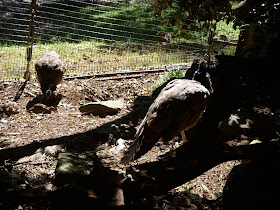More trips to the National Zoo, yay.
A red-billed hornbill in the Bird House.
In the same exhibit, some black crakes that were too active for me to photograph effectively.
A little blue heron.
A pygmy falcon. Cuteness is a thing among small endothermic predators, I tell ya.
A great argus. Many galliforms have elaborate courtship displays, and this one is no exception. The wings of the male can open up into an astounding display, somewhat reminiscent of the tail feathers of a peacock. Visitor comment on this animal: "What is that ugly crap?"
And kiwis still hate me, but that should go unsaid by now.
A double-wattled cormorant in the outdoor aviary. It having no fear of people, I was able to get a very good look at it preening its feathers. Later on it went for a swim and hopped onto a platform right in front of me, where it splashed and snapped at my face!
Some female smew.
A pair of peafowl with bamboo partridges nearby. I almost got a shot of a tragopan in the same frame as well, but it walked out of range as I snapped the picture.
A northern cardinal.
Perhaps the most surprising thing on this trip was that I ran into Rudyspino, a fellow online paleontology enthusiast! I'd known that he visited the National Zoo with some frequency (and have mentioned him on this blog in the past), but it was still rather unexpected. I recognized him as a fellow paleontology enthusiast thanks to him wearing a t-shirt bearing one of David Orr's wonderful designs ("Spinosauridae"), and Rudyspino being the only one I knew of who visited the National Zoo regularly I put two and two together. I accompanied him back into the outdoor aviary (I'd just been leaving the aviary when I bumped into Rudy) and to the seriema exhibit (one of his favorites at the zoo), and afterward he wanted to look at his favorite extant species, the ravens (whose existence at the zoo I'd told him about online mere days ago), which were on the American Trail.
On the way, I noticed this amusing sign I hadn't seen before.
I hadn't seen the ravens on my last visit to the American Trail, but fortunately for Rudy they were out and about this time. Who needs dinosauroids when you have the real thing?
We also had a good look at the hooded mergansers, gray wolves, seals, sea lions, and pelicans, but Rudy's luck didn't hold when we came to the bald eagles. (He's informed me that he has managed to see them on subsequent trips, however.) We parted ways soon afterward, as he had to leave. I continued onwards to the Small Mammal House.
A red ruffed lemur. It lived in a large exhibit (comparable to the South American themed one I've mentioned before) with rock hyraxes and blue-naped mousebirds. I caught a glimpse of a mousebird, but it flew into thick foliage before I could get a photo, while the hyaxes were nowhere to be seen. The lemur off to the left is actually a stuffed animal, by the way, acting as a temporary companion for the real lemur, who'd been alone in the exhibit when I visited.
A degu. The tail of these rodents break off easily when grabbed by a predator. Sadly, unlike lizard tails, these don't grow back. Degus display some surprisingly intelligent behaviors, known to spontaneously pile objects in order of decreasing size (something otherwise only observed in primates and birds) and capable of being taught to use tools.
An American alligator outside the Reptile Discovery Center.
A freshwater stingray on the lower floor of Amazonia.
A Goeldi's monkey on the upper floor. I don't recall seeing these on any of the signs at Amazonia (nor the actual animals themselves on previous trips), so I suspect they've been newly placed into the exhibit.
A silver-beaked tanager.
A tiger salamander in the amphibian exhibition at Amazonia.
A gray tree frog, native to eastern North America. Those who have read Thornton Burgess's stories will know it as Stickytoes the Tree Toad. (What do you mean, "You're the only one"?)
Some red-spotted newts.
Passing by the American Trail on my way back, I finally got to see the bald eagle.
On my previous trips to the National Zoo I'd seen signs for griffon vultures at the gazelle and oryx exhibit but had become really confused while trying to find them. I'd assumed they must've been flightless (either through wing clipping or permanent injury to the wing) because the exhibit was open air, and yet couldn't find any no matter how hard I searched across the ground and any low perches they could conceivably reach. This time, Rudy had informed me that he had seen a griffon vulture and that it was in a separate cage in the back of the gazelle and oryx exhibit. Right before I left the zoo I went and looked and lo and behold. I do wonder if the zoo has any further plans for the griffon vulture, as the exhibit looked rather cramped and drab compared to the general quality of the zoo's other enclosures, and it wasn't situated in a place conducive to visitor viewing (I took this picture on maximum zoom, for perspective).























No comments:
Post a Comment